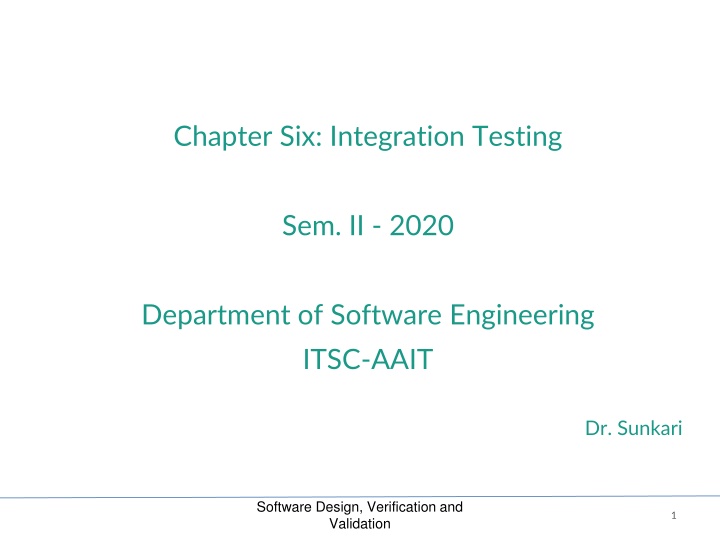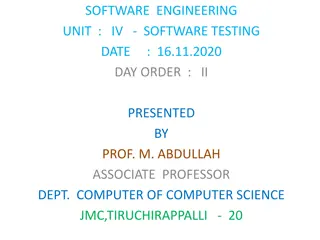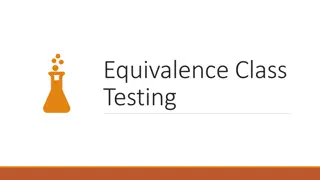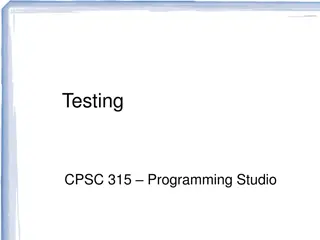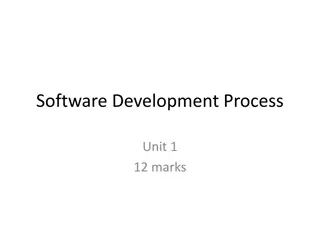Integration Testing in Software Engineering
Integration testing plays a crucial role in software development by combining individual modules to form a complete system, detecting defects early, facilitating easier defect fixing, and providing feedback on module health and system acceptability. Types of interfaces and interface errors are also discussed in the context of integration testing.
Download Presentation

Please find below an Image/Link to download the presentation.
The content on the website is provided AS IS for your information and personal use only. It may not be sold, licensed, or shared on other websites without obtaining consent from the author.If you encounter any issues during the download, it is possible that the publisher has removed the file from their server.
You are allowed to download the files provided on this website for personal or commercial use, subject to the condition that they are used lawfully. All files are the property of their respective owners.
The content on the website is provided AS IS for your information and personal use only. It may not be sold, licensed, or shared on other websites without obtaining consent from the author.
E N D
Presentation Transcript
Chapter Six: Integration Testing Sem. II - 2020 Department of Software Engineering ITSC-AAIT Dr. Sunkari Software Design, Verification and Validation 1
The Concept of Integration Testing A software module is a self-contained element of a system Modules are individually tested; commonly known as unit testing Next major task is to put the modules, i.e., pieces together to construct the complete system Construction of a working system from the pieces is not a straightforward task because of numerous interface errors The objective of system integration testing (SIT) is to build a working version of the system Putting modules together in an incremental manner Ensuring that the additional modules work as expected without disturbing the functionalities of the modules already put together Integration testing is said to be complete when The system is fully integrated together All the test cases have been executed All the severe and moderated defects found have been fixed. Software Design, Verification and Validation 2
The Concept of Integration Testing The major advantages of conducting SIT are as follows: Defects are detected early It is easier to fix defects detected earlier We get earlier feedback on the health and acceptability of the individual modules and on the overall system Scheduling of defect fixes is flexible, and it can overlap with development. Software Design, Verification and Validation 3
Types of Interfaces Three common paradigms for interfacing modules: Procedure call interface Shared memory interface Message passing interface The problem arises when we put modules together because of interface errors Interface errors Interface errors are those that are associated with structures existing outside the local environment of a module, but which the module uses. Software Design, Verification and Validation 4
Types of Interface Errors Inadequate error processing Construction Inadequate functionality Additions to error processing Location of functionality Inadequate post-processing Changes in functionality Inadequate interface support Added functionality Initialization/value errors Misuse of interface Violation of data constraints Misunderstanding of interface Timing/performance problems Data structure alteration Coordination changes Hardware/software interfaces Software Design, Verification and Validation 5
Granularity of System Integration Testing System Integration testing is performed at different levels of granularity Intra-system testing This form of testing constitutes low-level integration testing with the objective of combining the modules together to build a cohesive system. Inter-system testing It is a high-level testing phase which requires interfacing independently tested systems. Pairwise testing In pairwise integration, only two interconnected systems in an overall system are tested at a time. The purpose of pairwise testing is to ensure that two systems under consideration can function together, assuming that the other systems within the overall environment behave as expected. Software Design, Verification and Validation 6
System Integration Techniques Common approaches to perform system integration testing Incremental Top Down Bottom Up Big Bang Sandwich Pre-requisite A module must be available to be integrated A module is said to be available for combining with other modules when the module s check-in request form is ready. Software Design, Verification and Validation 7
Software Image and Build A software image is a compiled software binary. A build is an interim software image for internal testing within an organization Constructing a build is a process by which individual modules are integrated to form an interim software image. The final build is a candidate for system testing Constructing a software image involves the following activities Gathering the latest unit tested, authorized versions of modules Compiling the source code of those modules Checking in the compiled code to the repository Linking the compiled modules into sub - assemblies Verifying that the subassemblies are correct Exercising version control Software Design, Verification and Validation 8
Incremental Integration testing is conducted in an incremental manner as a series of test cycles In each test cycle, a few more modules are integrated with an existing ones, tested to generate larger builds. The complete system is built, cycle by cycle until the whole system is operational for system-level testing. The number of SIT cycles and the total integration time are determined by the following parameters: Number of modules in the system Relative complexity of the module ( Cyclomatic Complexity) Relative complexity of the interfaces between the modules Number of modules needed to be clustered together in each test cycle Whether the modules to be integrated have been adequately tested before Turnaround time for each test-debug-fix cycle. Software Design, Verification and Validation 9
Incremental A release note containing the following information accompanies a build. What has changed since the last build? What outstanding defects have been fixed? What are the outstanding defects in the build? What new modules, or features, have been added? What existing modules, or features, have been enhanced, modified, or deleted? Are there any areas where unknown changes may have occurred? A test strategy is created for each new build and the following issues are addressed while planning a test strategy. What test cases need to be selected from the SIT test plan? What previously failed test cases should now be re-executed in order to test the fixes in the new build? How to determine the scope of a partial regression tests? What are the estimated time, resource demand, and cost to test this build? Software Design, Verification and Validation 10
Top-down Module A has been decomposed into modules B, C, and D Modules B, D, E, F, and G are terminal modules. First integrate modules A and B using stubs C` and D` (represented by grey boxes) Next stub D` has been replaced with its actual instance D Two kinds of tests are performed: Test the interface between A and D Regression tests to look for interface defects between A and B in the presence of module D A module hierarchy with three levels and seven modules Top-down integration of modules A and B Top-down integration of modules A, B and D Software Design, Verification and Validation 11
Top-down Stub C` has been replaced with the actual module C, and new stubs E`, F`, and G` are incorporated Perform tests as follows: first, test the interface between A and C; second, test the combined modules A, B, and D in the presence of C The rest of the process depicted in the right hand side figures. Software Design, Verification and Validation 12
Top-down Advantages The SIT engineers continually observe system-level functions as the integration process continue Isolation of interface errors becomes easier because of the incremental nature of the top-down integration Test cases designed to test the integration of a module M are reused during the regression tests performed after integrating other modules. Disadvantages It may not be possible to observe meaningful system functions because of an absence of lower level modules and the presence of stubs. Test case selection and stub design become increasingly difficult when stubs lie far away from the top-level module. Software Design, Verification and Validation 13
Bottom-up We design a test driver to integrate lowest- level modules E, F, and G Return values generated by one module is likely to be used in another module. The test driver mimics module C to integrate E, F, and G in a limited way. The test driver is replaced with actual module , i.e., C. A new test driver is used At this moment, more modules such as B and D are integrated The new test driver mimics the behavior of module A Finally, the test driver is replaced with module A and further tests are performed Software Design, Verification and Validation 14
Bottom-up Advantages One designs the behavior of a test driver by simplifying the behavior of the actual module If the low-level modules and their combined functions are often invoked by other modules, then it is more useful to test them first so that meaningful effective integration of other modules can be done Disadvantages Discovery of major faults are detected towards the end of the integration process, because major design decision are embodied in the top-level modules Test engineers can not observe system-level functions from a partly integrated system. In fact, they can not observe system-level functions until the top-level test driver is in place. Software Design, Verification and Validation 15
Big-bang and Sandwich Big-bang Approach First all the modules are individually tested Next all those modules are put together to construct the entire system which is tested as a whole. Sandwich Approach In this approach a system is integrated using a mix of top-down, bottom-up, and big-bang approaches A hierarchical system is viewed as consisting of three layers. The bottom-up approach is applied to integrate the modules in the bottom-layer The top layer modules are integrated by using top-down approach The middle layer is integrated by using the big-bang approach after the top and the bottom layers have been integrated. Software Design, Verification and Validation 16
Software and Hardware Integration Integration is often done in an iterative manner A software image with a minimal number of core modules is loaded on a prototype hardware. A small number of tests are performed to ensure that all the desired software modules are present in the build. Next, additional tests are run to verify the essential functionalities The process of assembling the build, loading on the target hardware, and testing the build continues until the entire product has been integrated Software Design, Verification and Validation 17
Hardware Design Verification Tests A hardware engineering process consists of four phases Planning and specification Design, prototype implementation, and testing Integration with the software system Manufacturing, distribution and field service A hardware Design Verification Test (DVT) plan is prepared and executed by the hardware group before the integration with software system Software Design, Verification and Validation 18
Hardware Design Verification Tests The main hardware tests are as follows: Diagnostic Test Electrostatic Discharge Test Electromagnetic Emission Test Electrical Test Thermal Test Environment Test Equipment Handling and Packaging Test Acoustic Test Safety Test Reliability Test Software Design, Verification and Validation 19
Hardware and Software Compatibility Matrix H/W and S/W compatibility information is maintained in the form of a compatibility matrix. It documents different revisions of the H/W and S/W that will be used for official release of the product. An Engineering Change Order (ECO) is a formal document that describes a change to the hardware and software. An ECO document includes the hardware software compatible matrix. It is distributed to the operation, customer support and sales teams of the organization. Software Design, Verification and Validation 20
Test Plan for System Integration Software Design, Verification and Validation 21
Test Plan for System Integration Software Design, Verification and Validation 22
Test Plan for System Integration Software Design, Verification and Validation 23
Test Plan for System Integration Categories of System Integration Tests: Interface integrity Internal and external interfaces are tested as each module is integrated Functional validity Tests to uncover functional errors in each module after it is integrated End-to-end validity Tests are designed to ensure that a completely integrated system works together from end-to-end Pairwise validity Tests are designed to ensure that any two systems work properly when connected by a network Interface stress Tests are designed to ensure that the interfaces can sustain the load System endurance Tests are designed to ensure that the integrated system stay up for weeks Software Design, Verification and Validation 24
Off-the-self Component Integration Organizations occasionally purchase off-the-self (OTS) components from vendors and integrate them with their own components. Useful set of components that assists in integrating actual components Wrapper: It is a piece of code that one builds to isolate the underlying components from other components of the system. Glue: A glue component provides the functionality to combine different components. Tailoring: Components tailoring refers to the ability to enhance the functionality of a component Tailoring is done by adding some elements to a component to enrich it with a functionality not provided by the vendor. Tailoring does not involve modifying the source code of the component. Software Design, Verification and Validation 25
Off-the-self Component Testing OTS components produced by the vendor organizations are known as commercial off- the-shelf (COTS) components. A COTS component is defined as: A unit of composition with contractually specified interfaces and explicit context dependencies only. A software component can be deployed independently and is subject to composition by third parties Three types of testing techniques are used to determine the suitability of a COTS component: Black-box Component Testing: This is used to determine the quality of the component System-level Fault Injection Testing: This is used to determine how well a system will tolerate a failing component. Operational System Testing: This kind of tests are used to determine the tolerance of a software system when the COTS component is functioning correctly. Software Design, Verification and Validation 26
Built-in Testing Testability is incorporated into software components Testing and maintenance can be self-contained Normal mode The built-in test capabilities are transparent to the component user The component does not differ from other non-built-in testing enabled components. Maintenance mode The component user can test the component with the help of its built-in testing features The component user can invoke the respective methods of the component, which execute the test, evaluate autonomously its results, and output the test summary Software Design, Verification and Validation 27
Reading Software Testing and Quality Assurance: Theory and Practice Page [190-223] And read other online references Software Design, Verification and Validation 28
